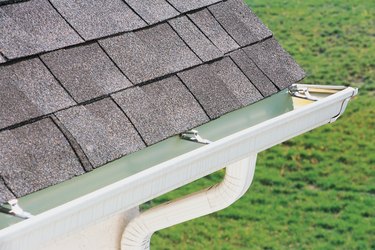
A strong storm, year-after-year of heavy rains and snow, and time itself will bring about an eventuality --- your roof shingles will need replacement. Whether you complete the repair job yourself or hire a contractor, a decision must be made on whether to use lap cement or roof cement to get the job done. Make the right choice to avoid additional damage to your home, such as a leak that can seep from the roof and into your house to damage your walls, furniture and other belongings.
Lap Cement
Video of the Day
Lap cement is an adhesive used to adhere roll roofing materials to rooftops. A roll roof is different from a shingle roof. Unlike conventional, individual shingles, roll roofing materials come in long sheets and are rolled onto the rooftop. Lap cement is applied with a brush or squeegee onto the rooftop base to adhere the roll roofing. Lap cement is referred to as a cold application, meaning that it doesn't need to be heated to bond the roofing material to the plywood or base material used for the rooftop. After the lap cement is applied, the roll roof material is also nailed to further reinforce and secure the roofing material to the rooftop.
Video of the Day
Roof Cement
Roof cement is a thick, black paste-like adhesive that's typically used to apply individual roofing shingles. Roof cement comes in cans and provides a quick fix for individual shingle replacements and repairs. You can lift up a shingle that's become askew, glide the roof cement onto the rooftop sheathing and repair the dislocated shingle. It can also be used to glue down new shingles, mend torn shingles and provide extra reinforcement when you repair a nail pop. In each case, you can simply slather a generous amount of roofing cement onto the base of the rooftop, press the shingle into place and nail it down.
Similarities
Lap cement and roof cement can be used for new roofing installations and to make repairs to existing roofs. Lap cement can be brushed onto the underside of replacement roll roofing material to repair edges or areas that have become unglued. If you use lap cement for a repair job, you should apply the lap cement to the back side of the roll roofing material and to the roof substrate base, and then apply pressure to help the materials to bond.
Differences
Lap cement is best used during warm, dry weather, when the temperature is at least 65 degrees Fahrenheit, with no threat of rain for at least 48 hours. Otherwise, the cement will not bond properly. Lap cement is more commonly used for new roofing installations rather than spot repairs. It comes in gallon-size cans, where roofing cement is available in pint and quart sizes. Another difference is that lap cement is a thinner and can be applied with a brush, roller or squeegee, while roofing cement is thick and requires a heavier flat tool for application, such as a trowel or spackling spatula. You can also use roof cement to camouflage nail heads for extra protection against water leaks and around flashings, chimneys and skylights. Lap cement, on the other hand, is not suitable for applications where it's exposed to air and moisture. It will bead up and lose its adhesion qualities.